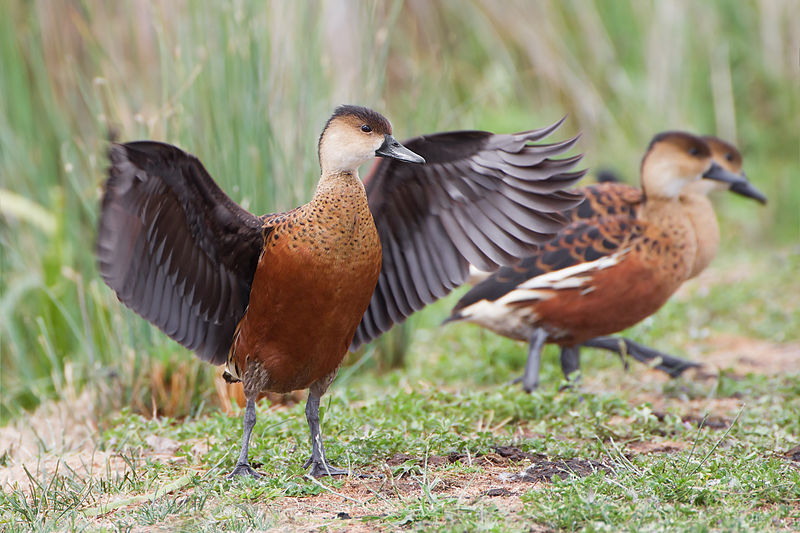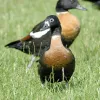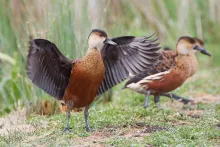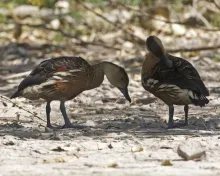
Wandering whistling duck (Dendrocygna arcuata australis)
Naamgeving
- Nederlandse naam:
- Wandering fluiteend
- Engelse naam:
- Wandering whistling duck
- Duitse naam:
- Wanderpfeifgans
- Franse naam:
- Dendrocygne à lunules
- Wetenschappelijke naam:
- Dendrocygna arcuata australis
Taxonomische indeling
- Orde:
- Anseriformes
- Familie:
- Anatidae
- Onderfamilie:
- Dendrocygninae
- Geslacht:
- Dendrocygna
Beschrijving
- Uiterlijke kenmerken:
Male:
With rich red-brown plumage overall, with a paler face, front of neck and upper breast. There is a dark stripe on the crown of head, nape and back of neck. The bill and legs are dark. There are elongated flank plumes, which are off-white with chestnut edges. In flight, the dark underwings, cinnamon and chestnut underbody, white undertail and trailing dark legs are seen.Female:
Similar to male. But sometimes with less elongated flank plumes.Juvenile:
Duller and lacking the broad pale feather edgings on the back ,so that mantle appears darker; underparts less chestnut and lacking some or all black spotting on sides of lower neck and upper chest. Chestnut on lesser wing-converts much reduced in extent and color, and entirely absent from median wing-converts. Bill, legs and feet paler grayish black.
- Gedrag:
Flocks are made up of pairs and their families. Sometime they 'adopt' stray Plumed whistling-duck (Dendrocygna eytoni) ducklings.
Strong, permanent pair bonds.
Maten en Gewicht
- Lengte man:
- De man (woerd) van de Wandering whistling duck heeft een lichaamslengte van ongeveer 55-60 centimeters. De vrouw (pop) heeft een lichaamslengte van ongeveer 52-58 centimeters.
- Gewicht man:
- Het mannetje weegt ongeveer 725-950 gram. Het vrouwtje weegt ongeveer 710-900 gram.
Het gewicht is notoir variabel en kan alleen als indicatie worden gebruikt!
- Ondersoorten:
There is three subspecies:
- Dendrocygna arcuata arcuata - East Indian Wandering Whistling Duck
- Dendrocygna arcuata australis - Australian Wandering Whistling Duck
- Dendrocygna arcuata pygmaea - Lesser Wandering Whistling Duck
- Notitie:
Whistling-ducks generally do well, either in pens or in a park with access to extensive water area and good natural cover. They are gregarious outside the breeding season, and groups may bully smaller duck species, so should be kept in large areas, in which other birds have room to escape. Most need shelter in severe weather and a well-sheltered pen with frost-free night quarters for winter is suggested, or plenty of ground cover and/or straw to stand on, as they are susceptible to frostbite. They may be kept fully-flighted in aviaries, and have also been kept full-winged in open pens, tending not to wander. Perches should be provided at an appropriate height for pinioned or wing-clipped birds. Commercial pellets and grain are suitable for feeding.
Elevated nest boxes are appreciated by most species, although pinioned birds will use ground-level boxes; boxes may be placed over water or land. Eggs may be incubated by bantams and ducklings may be bantam-reared. Many species have been successfully parent-reared in captivity. Pairs kept isolated and fully flighted in a covered pen, with high-hung nest boxes "seldom fail to rear broods". Whistling-duck species may hybridise with one another and therefore should be kept in separate enclosures, and hybridisation has also occasionally been reported with Rosy-billed pochard (Netta peposaca).
This is one of the least hardy of the whistling-ducks. These ducks may be maintained in groups or in mixed collections. Enclosures containing a pond with substantial vegetation and a water depth of at least 1m are preferred, although they may also be kept in aviaries. A soft substrate such as grass is prefered and appropriate low, large-diameter perches should be provided. They may also easily be stressed by capture.
Breeding success has been very good in recent years in Australia. Wandering whistling ducks nest on the ground, under the protection of long grass or a bush, not necessarily near water; they also use hollow logs and ground-level or raised nest boxes. These ducks normally lay May to June. Use of overhead sprinklers (approximately one hour every other day) in combination with increased protein in the diet may stimulate breeding.
Ducklings may be parent reared (parents are very protective). Artificially reared ducklings should be kept in their own group - they tend to attack strange birds. The ducklings eat voraciously and care should be taken to provide sufficient food or the lowest-ranking ducklings may not get to eat; if necessary, obviously undersized birds should be removed and reared separately.
Artificial incubation and rearing may be used, although imprinting may occur if they are given much contact with humans in the first 4-6 hours after hatching. Broodies may also be used, and ducklings have been reared successfully by Plumed whistling-duck (Dendrocygna eytoni) and Maned duck (Chenonetta jubata).
Wandering whistling-ducks readily hybridise with Fulvous whistling-duck (Dendrocygna bicolor) and should be kept separate from that species; they have also been known to hybridise with Plumed whistling-duck (Dendrocygna eytoni).
- Breeding:
- Het vrouwtje Wandering whistling duck legt doorgaans zo'n 10-12 creamy white eieren het broeden duurt 28-30 dagen.
- Kunstmatig broeden:
De ideale relatieve luchtvochtigheid voor het uitbroeden van de meeste watervogeleieren is 55% voor grondbroeders en 40% bij holenbroeders. De temperatuur is meestal 37,4° C. Stel ventilatie in zoals aanbevolen door de fabrikant van de broedmachine. Eieren moeten minimaal 4 keer per dag automatisch of met de hand worden gedraaid. Naarmate de vrucht zich ontwikkelt, verliest het ei water en wordt de luchtzak groter. Bij normale ontwikkeling van een ei met een incubatietijd van 28-30 dagen neemt de luchtzak ongeveer een derde van het ei in beslag, dit bij drie dagen voor uitkomst. Reinheid is van vitaal belang en idealiter moet de luchtvochtigheid worden verhoogd tot 65% nadat de eerste tekenen van uitkomst zichtbaar worden.
- Ringdagen:
- Aanbevolen passende ringmaat voor de Wandering whistling duck is 12 mm.De gesloten pootring kan alleen aangebracht worden bij een jonge whistling duck van ongeveer 12-14 dagen oud.
- It doesn't matter what leg that you band, but it's good to have a consistent system. Suggested: Left leg = Female, Right leg = Male
- Onderhoudsvoeder:
-





Floating full food for all sea ducks, green ducks, eider ducks and geese, especially in the moulting and breeding phase ideally suited. Packed with wholesome raw materials, natural vitamins and trace elements, this performance food with a protein content of 30% forms the basis for lifelong vitality.




